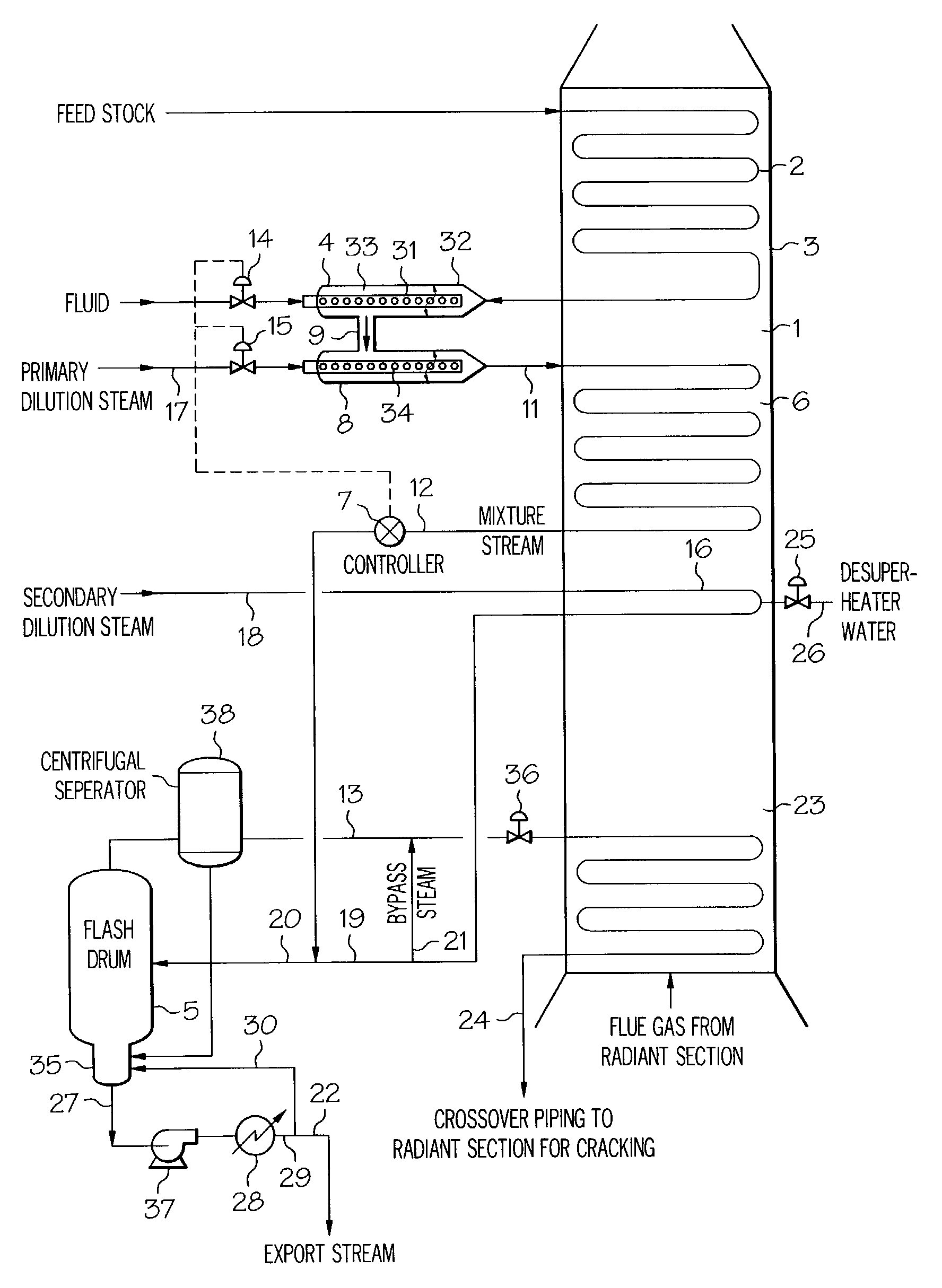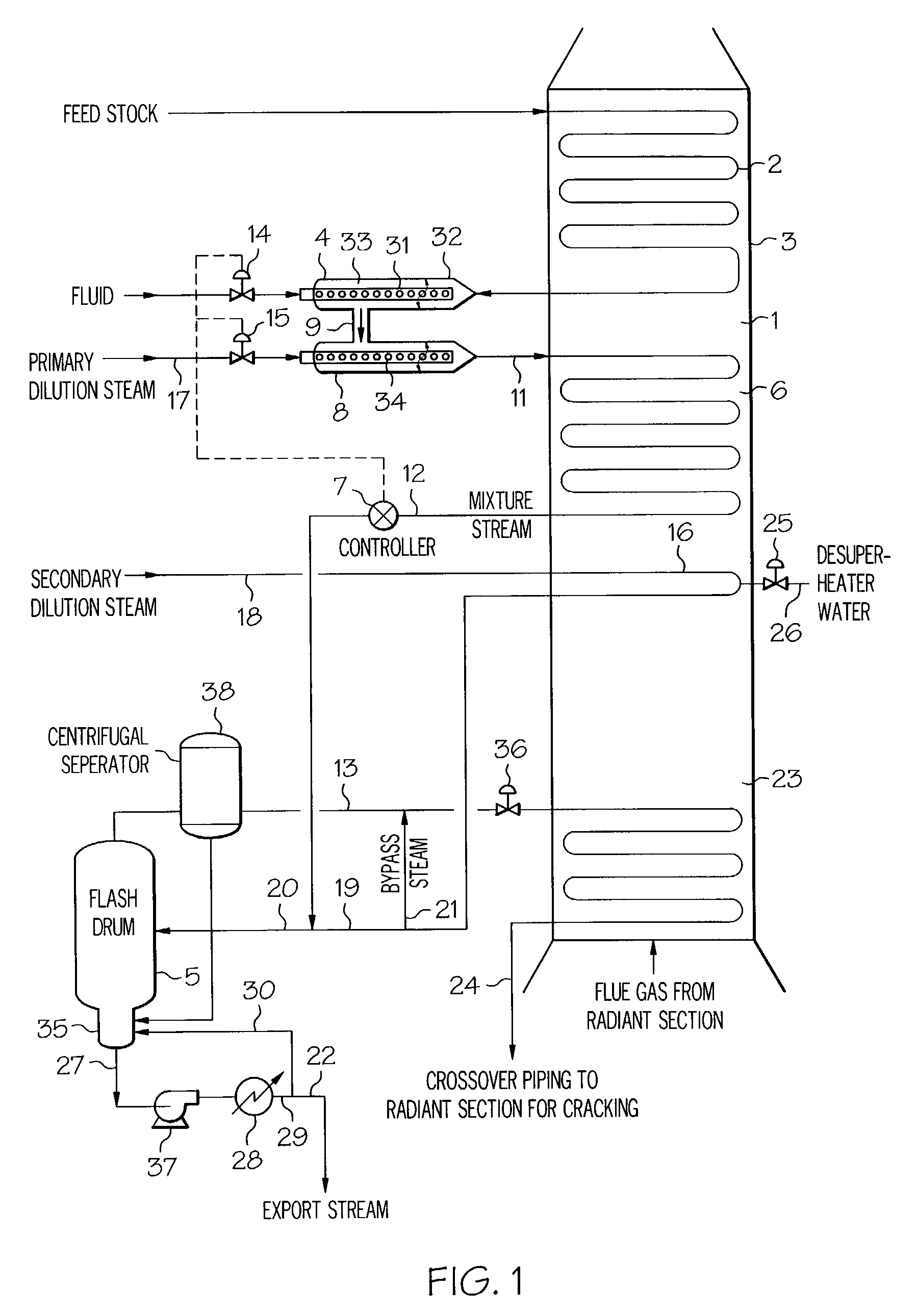Process for steam cracking heavy hydrocarbon feedstocks
a hydrocarbon feedstock and steam cracking technology, applied in the cracking process of hydrocarbon oil, thermal non-catalytic cracking, organic chemistry, etc., can solve the problems of crude oil, coking problems, contamination of naphthas,
- Summary
- Abstract
- Description
- Claims
- Application Information
AI Technical Summary
Benefits of technology
Problems solved by technology
Method used
Image
Examples
example 1
[0066]Engineering calculations which simulate processing atmospheric pipestill bottoms (APS) and crude oil by this invention have been conducted. The attached Table 1 summarizes the simulation results for cracking Tapis APS bottoms and Tapis crude oil in a commercial size furnace with a flash drum. The very light components in crudes act like steam reducing the partial pressure of the heavy components. Hence, at a nominal 950° F. (510° C.) cut point, the flash drum can operate 100° F. (50° C.) lower temperature than for atmospheric resids.
[0067]
TABLE 1Summary of Atmospheric Pipestill (APS) Bottomsand Crude Oil Flash Drum SimulationsAPSFIG. 1BottomsCrudeRef. #Convection feed rate, klb / hr (t / h)126(57)100(45)n / a950° F. minus (510° C.), wt %7093n / aTemperature before sparger, ° F.400(205)352(178)4(° C.)Sparger water rate, klb / h (t / h)12(5)43(20)14Primary dilution steam rate,18(8)8(4)17klb / h (t / h)Secondary dilution steam rate,17(8)19(9)18klb / h (t / h)Desuperheater water rate,6(3)6(3)26klb / h ...
example 2
[0068]Table 2 summarizes the simulated performance of the flash for residue admixed with two concentrations of C4's. At a given flash temperature, pressure and steam rate, each percent of C4's admixed with the residue increases the residue vaporized in the flash by ¼%. Therefore, the addition of C4's to feed will result in more hydrocarbon from the residue being vaporized.
[0069]
TABLE 2C4's / Residue Admixture Flash PerformancePureMix 1:Mix 2:ResidueResidue + C4'sResidue + C4'sWt % residue in convection1009489feedWt % C4's in convection0611feedBubble point, ° F.991327244@ 112 psigWt % of residue vaporized65.0%68.2%70.8%in flashOverall wt % vaporized65.0%69.9%74.0%in flashTemperature, ° F.819819819Wt % of residue vaporized70.0%72.8%75.1%in flashOverall wt% vaporized in70.0%74.3%77.8%flashTemperature, ° F.835835835Wt % of residue vaporized75.0%77.4%79.4%in flashOverall wt % vaporized75.0%78.6%81.7%in flashTemperature, ° F.855855855
PUM
| Property | Measurement | Unit |
|---|---|---|
| temperature | aaaaa | aaaaa |
| boiling point | aaaaa | aaaaa |
| boiling point | aaaaa | aaaaa |
Abstract
Description
Claims
Application Information
 Login to View More
Login to View More - R&D
- Intellectual Property
- Life Sciences
- Materials
- Tech Scout
- Unparalleled Data Quality
- Higher Quality Content
- 60% Fewer Hallucinations
Browse by: Latest US Patents, China's latest patents, Technical Efficacy Thesaurus, Application Domain, Technology Topic, Popular Technical Reports.
© 2025 PatSnap. All rights reserved.Legal|Privacy policy|Modern Slavery Act Transparency Statement|Sitemap|About US| Contact US: help@patsnap.com


